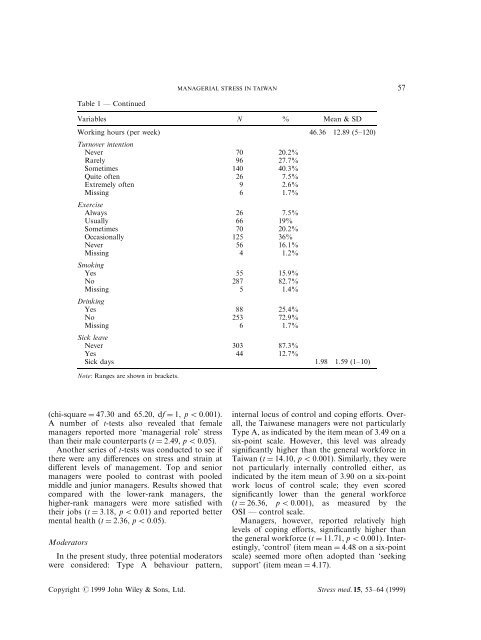Managerial stress, job satisfaction and health in Taiwan
Managerial stress, job satisfaction and health in Taiwan
Managerial stress, job satisfaction and health in Taiwan
You also want an ePaper? Increase the reach of your titles
YUMPU automatically turns print PDFs into web optimized ePapers that Google loves.
MANAGERIAL STRESS IN TAIWAN 57Table 1 Ð Cont<strong>in</strong>uedVariables N % Mean & SDWork<strong>in</strong>g hours (per week) 46.36 12.89 (5±120)Turnover <strong>in</strong>tentionNever 70 20.2%Rarely 96 27.7%Sometimes 140 40.3%Quite often 26 7.5%Extremely often 9 2.6%Miss<strong>in</strong>g 6 1.7%ExerciseAlways 26 7.5%Usually 66 19%Sometimes 70 20.2%Occasionally 125 36%Never 56 16.1%Miss<strong>in</strong>g 4 1.2%Smok<strong>in</strong>gYes 55 15.9%No 287 82.7%Miss<strong>in</strong>g 5 1.4%Dr<strong>in</strong>k<strong>in</strong>gYes 88 25.4%No 253 72.9%Miss<strong>in</strong>g 6 1.7%Sick leaveNever 303 87.3%Yes 44 12.7%Sick days 1.98 1.59 (1±10)Note: Ranges are shown <strong>in</strong> brackets.(chi-square ˆ 47.30 <strong>and</strong> 65.20, df ˆ 1, p 5 0.001).A number of t-tests also revealed that femalemanagers reported more `managerial role' <strong>stress</strong>than their male counterparts (t ˆ 2.49, p 5 0.05).Another series of t-tests was conducted to see ifthere were any di€erences on <strong>stress</strong> <strong>and</strong> stra<strong>in</strong> atdi€erent levels of management. Top <strong>and</strong> seniormanagers were pooled to contrast with pooledmiddle <strong>and</strong> junior managers. Results showed thatcompared with the lower-rank managers, thehigher-rank managers were more satis®ed withtheir <strong>job</strong>s (t ˆ 3.18, p 5 0.01) <strong>and</strong> reported bettermental <strong>health</strong> (t ˆ 2.36, p 5 0.05).ModeratorsIn the present study, three potential moderatorswere considered: Type A behaviour pattern,<strong>in</strong>ternal locus of control <strong>and</strong> cop<strong>in</strong>g e€orts. Overall,the <strong>Taiwan</strong>ese managers were not particularlyType A, as <strong>in</strong>dicated by the item mean of 3.49 on asix-po<strong>in</strong>t scale. However, this level was alreadysigni®cantly higher than the general workforce <strong>in</strong><strong>Taiwan</strong> (t ˆ 14.10, p 5 0.001). Similarly, they werenot particularly <strong>in</strong>ternally controlled either, as<strong>in</strong>dicated by the item mean of 3.90 on a six-po<strong>in</strong>twork locus of control scale; they even scoredsigni®cantly lower than the general workforce(t ˆ 26.36, p 5 0.001), as measured by theOSI Ð control scale.Managers, however, reported relatively highlevels of cop<strong>in</strong>g e€orts, signi®cantly higher thanthe general workforce (t ˆ 11.71, p 5 0.001). Interest<strong>in</strong>gly,`control' (item mean ˆ 4.48 on a six-po<strong>in</strong>tscale) seemed more often adopted than `seek<strong>in</strong>gsupport' (item mean ˆ 4.17).Copyright # 1999 John Wiley & Sons, Ltd. Stress med. 15, 53±64 (1999)
















